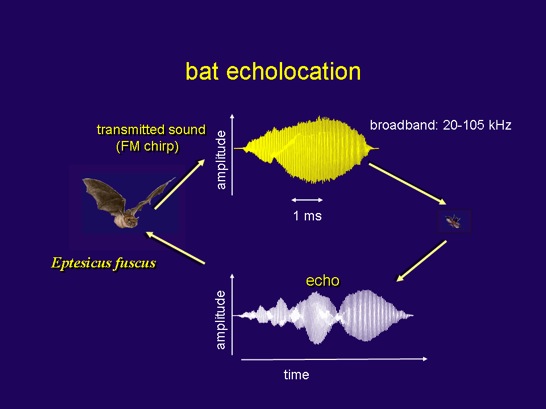Michrochiropteran Echolocation
Meg Moeller Neil Evans
Biology 342 Fall 2010
Mechanism
(What are the proximate causes of the behavior? How do these causes function mechanistically to regulate the behavior?)
Microbats all have evolved large pinnae (the external part of the ear), improving their hearing. Due to the fact that high frequency sounds rapidly decrease in loudness as they travel through the air, microbats had to evolve sensitive hearing for the returning waves and some method of keeping themselves from becoming deaf. One way is by emitting echolocation sounds in short bursts. While they are making the noise, some bats are able to temporarily deafen themselves, and then undeafen to receive the returning waves. This is possible because there is a small muscle in the ear attached to the stapes (vibrations in the ear travel from the tympanic membrane to the ossicles (of which the stapes is one) and to the inner ear). This small muscle contracts and pulls the stapes away from the oval window to the inner ear, stopping the sound from damaging sensitive inner ear components. As soon as the pulse has been emitted, the muscle relaxes again and the bat’s hearing is completely restored. (Altringham, 1998 p83-84)
Echolocation is an active process used by animals to sense the environment when vision is ineffective, such as at night. By comparing the outgoing pulse with the returning echoes, the bats brain can produce images of the surroundings. The location of a target in three dimensions can be determined from its range and direction. Range can in turn be determined from measuring the time delays between sound production and reception. Echo strength can give cues about target size, surface texture may be determined from peaks and troughs in the frequency spectrum of the echo, and direction of motion can be determined. Bats produce sounds in the larynx, direct the pulses through the mouth or nostrils, and receive echoes at their large pinnae. (Gareth Jones, 2005)
Since small wires can be detected at distances of as much as 5500 times the wire diameter, and well before the bat gives evidence by its flight pattern that it is aware of them, it appears likely that larger objects are detected at considerably greater distances. (Alan Grinnell, 1958)
Table comparing the two strategies employed by bats. Either can be used or a combination of both.
| FM | CF | |
| Purpose | Extreme precision of target | Detects motion and wing beats |
| Frequencies transmitted | Broadband sweep | Small frequency band |
| Improved by | Can be boosted further with harmonic frequencies | The bat will lower the frequency to compensate for Doppler shifts to detect motion |
| Advantage | Ignores background noise | Distance motion detector using Doppler shifts |
| Quick call allows obstacle avoidance and up to date prey information | ||
| Disadvantage | Range of detection (Fenton 1995) | Long range of detection |
| Reason? | Echo is in the right frequency range only for a moment (Grinnell 1995) | Only uses a narrow frequency band so the echo can be interpreted |
| Environment used | Dense vegetation | Open enviroments |
 Most species emit only one type of pulse. The hunting strategies of the species is directly related to the characteristics of its biosonar.
Most species emit only one type of pulse. The hunting strategies of the species is directly related to the characteristics of its biosonar.
Differences between the bats’ ears in intensity and arrival time of sound give the azimuth of the target, whereas the interference pattern of sound waves reflected within the structure of the outer ear gives the elevation. (Suga, 1990)
Bats transmit two types of acoustic signals: either constant frequency (CF) or frequency modulated (FM). Some transmit only CF, some only FM, some both. For ‘both’ bats: There are three distinct phases to the echolocation attack sequence of a bat approaching airborne prey: detection, approach, and terminal. During the detection phase, the bat transmits long CF pulses, at a low pulse repetition frequency. The approach pulses are shorter CF and are transmitted at higher pulse repetition frequency. Terminal pulses are descending FM of short duration and high pulse repetition frequency. Acoustic wave forms vary widely between species. Even within a species individual bats very their acoustic transmissions considerably, depending on environment. (Mark Denny, 2004)
During detection phase, bats can discriminate between different target types of the same size, and identify the species.
During approach phase, the target has been detected and classified as prey and is being tracked. This requires knowledge of the targets spatial location and velocity
During the terminal phase, the bat can resolve in range features of the prey that are separated by just a few millimeters. It can follow these features in time, pulse by pulse, to see hw the insect oscillates as it beats its wings. (Mark Denny, 2004)
Echolocation of a FM bat and the waves produced. Image from sholarpedia.